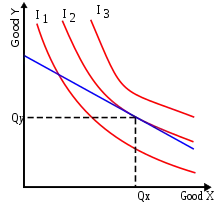Budget constraint
In economics, a budget constraint represents all the combinations of goods and services that a consumer may purchase given current prices within his or her given income. Consumer theory uses the concepts of a budget constraint and a preference map to analyze consumer choices. Both concepts have a ready graphical representation in the two-good case. The consumer can only purchase as much as their income will allow, hence they are constrained by their budget.[1] The equation of a budget constraint is where P_x is the price of good X, and P_y is the price of good Y, and m = income.

Uses
Individual choice

Consumer behaviour is a maximization problem. It means making the most of our limited resources to maximize our utility. As consumers are insatiable, and utility functions grow with quantity, the only thing that limits our consumption is our own budget.[2]
In general, the budget set (all bundle choices that are on or below the budget line) represents all possible bundles of goods an individual can afford given their income and the prices of goods. When behaving rationally, an individual consumer should choose to consume goods at the point where the most preferred available indifference curve on their preference map is tangent to their budget constraint. The tangent point (the xy coordinate) represents the amount of goods x and y the consumer should purchase to fully utilize their budget to obtain maximum utility.[3] It is important to note that the optimal consumption bundle will not always be an interior solution. If the solution to the optimality condition leads to a bundle that is not feasible, the consumer's optimal bundle will be a corner solution which suggests the goods or inputs are perfect substitutes. A line connecting all points of tangency between the indifference curve and the budget constraint is called the expansion path.[4]
All two dimensional budget constraints are generalized into the equation:
Where:
- money income allocated to consumption (after saving and borrowing)
- the price of a specific good
- the price of all other goods
- amount purchased of a specific good
- amount purchased of all other goods
The equation can be rearranged to represent the shape of the curve on a graph:
, where is the y-intercept and is the slope, representing a downward sloping budget line.
The factors that can shift the budget line are a change in income (m), a change in the price of a specific good (), or a change in the price of all other goods ().
International economics

A production-possibility frontier is a constraint in some ways analogous to a budget constraint, showing limitations on a country's production of multiple goods based on the limitation of available factors of production. Under autarky this is also the limitation of consumption by individuals in the country. However, the benefits of international trade are generally demonstrated through allowance of a shift in the consumption-possibility frontiers of each trade partner which allows access to a more appealing indifference curve. In the "toolbox" Hecksher-Ohlin and Krugman models of international trade, the budget constraint of the economy (its CPF) is determined by the terms-of-trade (TOT) as a downward-sloped line with slope equal to those TOTs of the economy. (The TOTs are given by the price ratio Px/Py, where x is the exportable commodity and y is the importable).
Many goods
While low-level demonstrations of budget constraints are often limited to less than two good situations which provide easy graphical representation, it is possible to demonstrate the relationship between multiple goods through a budget constraint.
In such a case, assuming there are goods, called for , that the price of good is denoted by , and if is the total amount that may be spent, then the budget constraint is:
Further, if the consumer spends his income entirely, the budget constraint binds:
In this case, the consumer cannot obtain an additional unit of good without giving up some other good. For example, he could purchase an additional unit of good by giving up units of good
Borrowing and lending
Budget constraints can be expanded outward or contracted inward through borrowing and lending. By borrowing money in a period, usually at an interest rate r, a consumer can choose to forgo consumption in future periods for extra consumption in the borrowing period. Choosing to borrow would expand the budget constraint in this period and contract budget constraints in future periods. Alternatively, consumers can choose to lend their money in the current period, usually at a lending rate l. Lending contracts the budget constraint in the current period but expands budget constraints in future periods.[1] According to behavioral economics, choices on borrowing and lending may also be affected by Present bias. In economics, there are two groups of present biased individuals, sophisticated individuals who are aware of their present bias, and naive individuals who are not aware of their present bias.[5]
See also
- Choice modelling
- Contingent valuation
- Guns versus butter model
- Heckscher–Ohlin theorem on country level budget constraints called resource endowments
- Intertemporal budget constraint
- Opportunity cost
- Scarcity
- Trade-off
Notes
- Allingham, Michael (1987). Wealth Constraint, The New Palgrave: A Dictionary of Economics, doi:10.1057/978-1-349-95121-5_1886-1
- "Budget constraint | Policonomics".
- Lipsey (1975). p 182.
- Salvatore, Dominick (1989). Schaum's outline of theory and problems of managerial economics, McGraw-Hill, ISBN 978-0-07-054513-7
- O'Donoghue, Ted, and Matthew Rabin. 2015. "Present Bias: Lessons Learned and to Be Learned." American Economic Review, 105 (5): 273-79.
References
- Lipsey, Richard G. (1975). An Introduction to Positive Economics (Fourth ed.). Weidenfeld & Nicolson. pp. 214–7. ISBN 0-297-76899-9.
